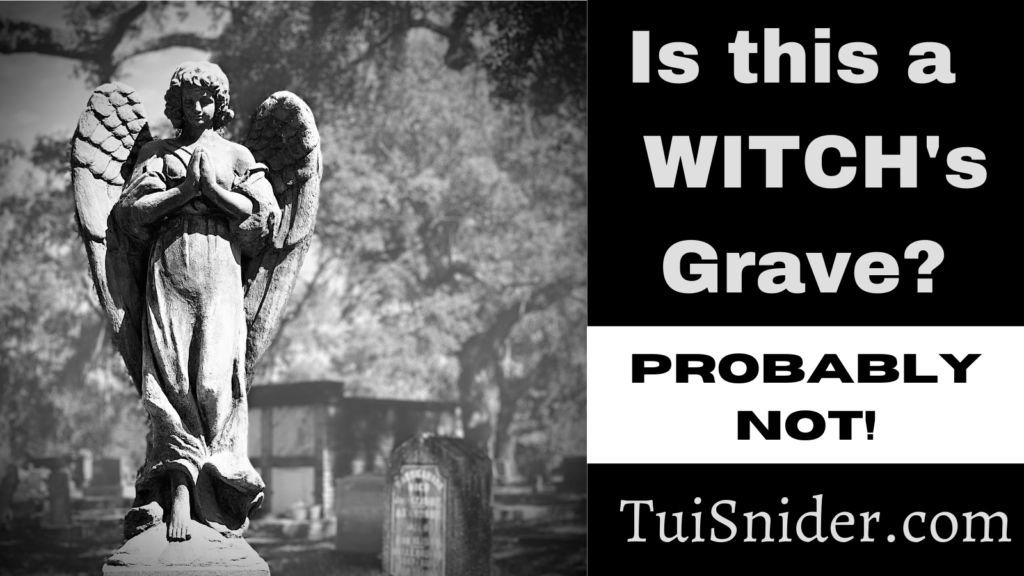
Part One: Witch’s Tombs & Misunderstood Cemetery Symbols
Throughout the year, and especially as Halloween approaches, well-intentioned people forward me articles about alleged Witch’s Tombs that have no basis in fact. This is the first of two blog posts in which I explain why you should be suspicious of Witch’s Tombs.
Part One: In this post (which you are currently reading) I explain the problem with Witch’s Tombs, offer two examples, and explain how I think they are created.
Part Two: In this post, I describe the three cemetery symbols most commonly misconstrued as having ties to witchcraft and/or satanism. I also talk about a real witch’s grave and the symbol that appears on its headstone. (Here’s the link to Part Two.)
Witch’s Tombs in Texas
As someone who writes books about historic graveyards and gives presentations on the meanings of cemetery symbols, I love it when readers and audience members make research suggestions.
Have you heard of this symbol? Have you been to this cemetery? Do you know the story behind this headstone? Such inquiries are music to my ears.
On the other hand, when people tell me about supposed “witch’s tombs,” my stomach does a flip-flop. I brace myself for a load of misinformation and try to craft a tactful reply.
Don’t get me wrong. Local legends are fun, and I get a kick out of them as much as anyone else. Most of the books I write include strange-but-true history: A mob that lynched Santa Claus, an embalmed lizard displayed in a county courthouse, and an axe murderer who became a marriage counselor are just a few topics I’ve researched for my books.
In fact, the Lone Star State is so laden with strange-but-true topics my running joke is, “I used to write fiction, but then I moved to Texas!”
What I object to is when people leave the “but true” part out of the “strange-but-true.” And yet, that is the problem with every single alleged “witch’s tomb” I’ve encountered here. Here in Texas, I have not come across a single instance where someone stood trial, or was executed, for witchcraft (voodoo, on the other hand, is another story for another day.)
Unless you are talking about a place where a genuine witch hunt occurred, such as Salem doing the 1600s, most so-called “witch’s graves” are rarely ever the burial site for an actual witch. Instead, they are urban legends with little to no truth to them.
Recipe for a “witch’s tomb”
So what is going on? Why are there so many completely untrue legends about “witch’s tombs” in Texas and other parts of the US? For starters, I’ve noticed that these “witch’s tombs” often follow a similar “recipe.”
Recipe for a Witch’s Tomb: Take one unusual headstone or cemetery symbol. In lieu of actual research, stir in spooky rumors and half-baked ideas. Tell all your friends. Mix well…and voilà! You have created another “witch’s tomb.” (Recipe works best if there are no living family members in the area.)
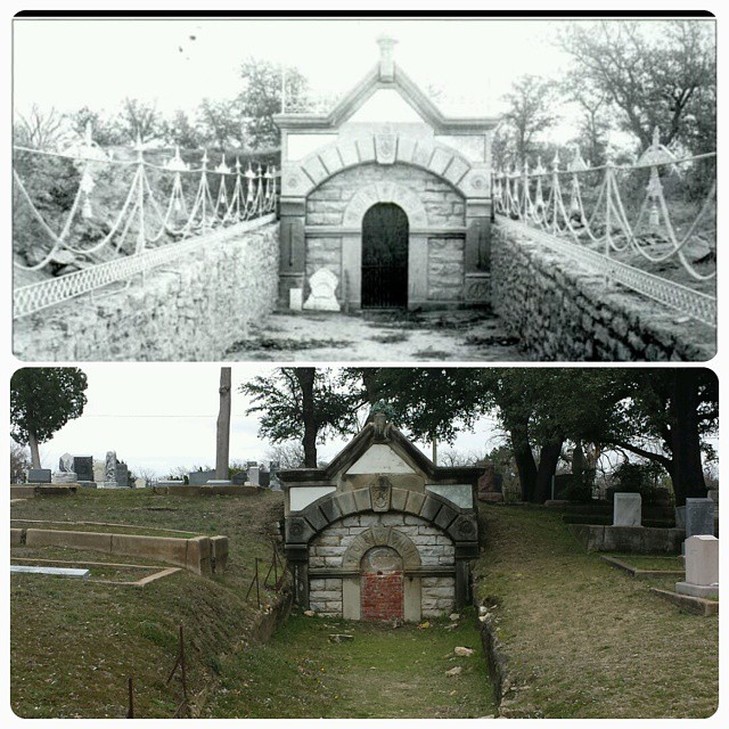
Case in point: Weatherford’s Witch Tomb
Old City Cemetery in Weatherford, Texas is home to a very unique mausoleum. Built from limestone and marble and decorated with carvings of lilies, roses, and leaves, this unusual crypt is half-buried in the hillside. A sunken pathway that was once lined with a decorative chain and wrought iron fencing leads up to the entrance. [The best photo I’ve seen of the original tomb is on Arnold Bustillo’s blog.]
Obvious facts ignored
Despite the fact that “Hiram E. Swain born January 28th 1836 died November 18 1883” is clearly engraved above the door, a local legend claims this is a witch’s tomb.
Like so many false urban legends, the stories surrounding Mr. Swain’s grave are varied and convoluted. Some say that if you knock on the door of this tomb at midnight, the witch within knocks back. Another tale claims that a white witch was buried there by her grieving mortal lover.
The truth about Hiram E. Swain
In truth, Hiram E. Swain was a retired sea captain turned successful businessman. As president of the Crystal Palace Flouring Mills Company, he was quite well-to-do. Like so many of his era, he did not wait until the last minute to make his burial plans. He used his wealth to commission a grand family vault for the Swain family.
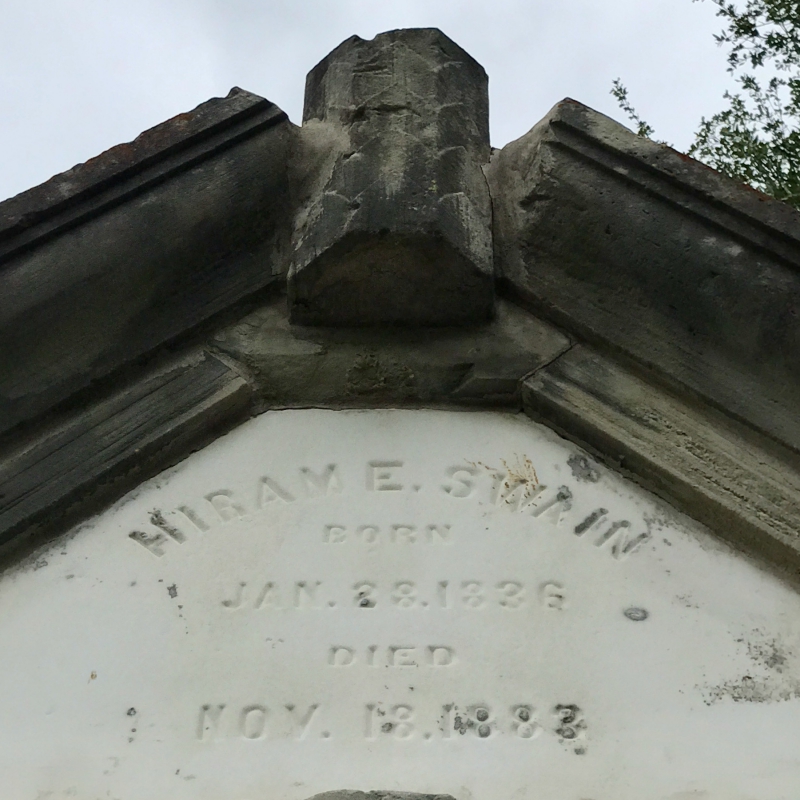
When Mr. Swain’s health declined in 1883, he traveled to California, hoping the change of climate would restore his health. It didn’t work out, and he died during his trip. Even so, an article about his death in the Fort Worth Daily Gazette remarked that, “He was in the prime of life, full of energy and enterprise, and was a valued member of our social and business world.”
Hardly sounds like a witch or wizard!

The real inhabitants of this Witch’s Grave
Mr. Swain’s remains were shipped back to Texas. Although there is no epitaph for her, an infant daughter shares the family vault with Hiram E. Swain, as well.
Eventually, Swain’s widow remarried. She, too, is buried in Old City Cemetery, but in a grave with her second husband. With no living descendants, over time the true story behind Hiram E. Swain’s fancy mausoleum was displaced by an urban legend claiming that it’s a witch’s tomb.
Local historians know the truth, and I have found newspapers articles from the 1980s attempting to set the record straight, but this false urban legend endures.
Unfortunately, even having living relatives isn’t always enough to dispel a negative urban legend.
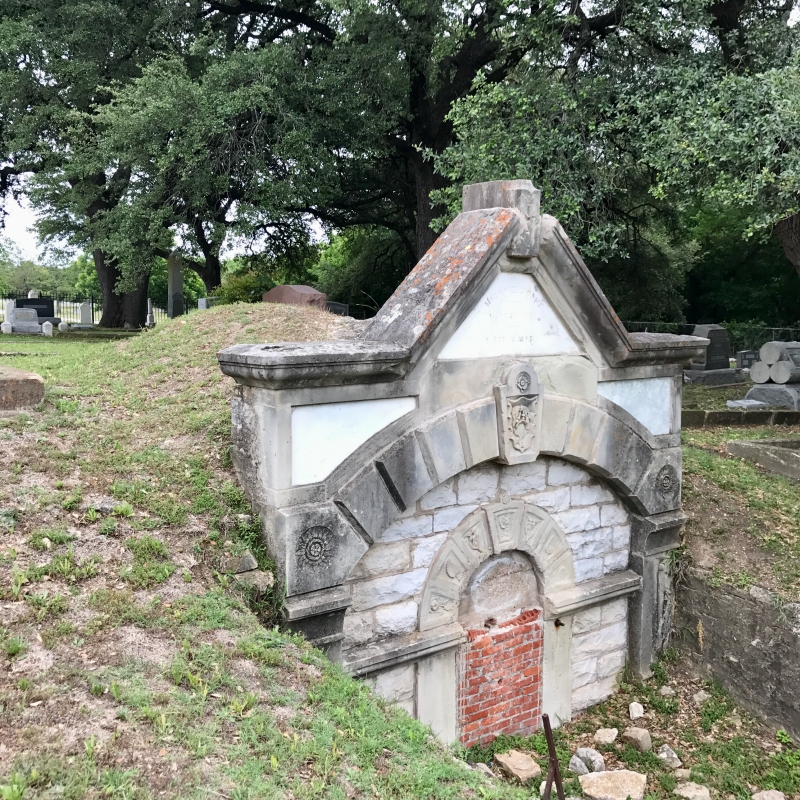
Case in point: Liberty Hill Witch Gave in Bittick Family Cemetery
For decades, a small burial ground north of Liberty Hill, Texas has been plagued by vandalism thanks to an urban legend claiming there’s a witch buried there. According to this tale, a slave named Elizabeth Simpson was buried in Bittick Family Cemetery after being executed for witchcraft.
While it’s true there was a woman named Elizabeth Simpson buried here in 1864, nothing else about this urban legend is a fact. Elizabeth was not a witch, nor was she a slave. She was a white woman who moved from Louisiana to Texas and died from illness at the age of 30. Rather than being anything sensational, Elizabeth Simpson’s life and death are sadly typical for settlers of that time.
Historic family cemetery repeatedly vandalized
The Bittick family, who has maintained this historic burial ground since the 1980s, has no idea why Elizabeth’s grave has been targeted. But for some reason, so many people have chipped away pieces of her headstone that little remains. Visitors often leave grave goods and even garbage at her burial site including, at times, used condom wrappers. Yuck!
Targeted due to her epitaph?
What is it about Elizabeth Simpson’s grave that has made it such a target for abuse? Strange as it seems, it may have been triggered by her epitaph, which reads:
And remember as yo ar pasin by yo must die as well as I
It’s an unusual epitaph, if only for the amount of misspelled words. The sentiment itself is pretty familiar, if you spend much time in historic cemeteries. (Not the exact wording, mind you, but many variations of, “As am I, so will you someday be,” are fairly common on headstones from the Victorian Era and earlier.)
Common sentiment – not a curse
So it’s quite possible that after puzzling over Elizabeth Simpson’s epitaph, cemetery visitors and their friends created a legend to explain it rather than do any actual research. In my experience, some people respond to things they don’t understand by making up erroneous explanations. In the case of Elizabeth Simpson, the urban legend claims that her epitaph is actually a type of curse.
Lingering falsehood appears in books
Unfortunately, once damaging urban legends take root, they are hard to eradicate. The slanderous legend about Elizabeth Simpson has even appeared in popular books which claim to contain true Texas history, which is very disappointing, to say the least.
It’s upsetting when the deceased are slandered like this! And there’s really no excuse to spread these false stories in this day and age.
To learn more, here are some articles that go into much more detail about Elizabeth Simpson’s grave at Bittick Family Cemetery:
Liberty Hill Witch Grave: Bad Legends and Cemetery Desecration
‘Witch’s Grave’ Legend Destroying Family Cemetery, Real History
Next: 3 Commonly Misunderstood Cemetery Symbols
That’s all for now. In my next post, I describe three cemetery symbols that are commonly misconstrued as having ties to witchcraft and/or satanism. I also talk about a real witch’s grave and the symbol that appears on its headstone. Follow this link to read Part Two: Witch’s Tombs & 3 Misunderstood Cemetery Symbols
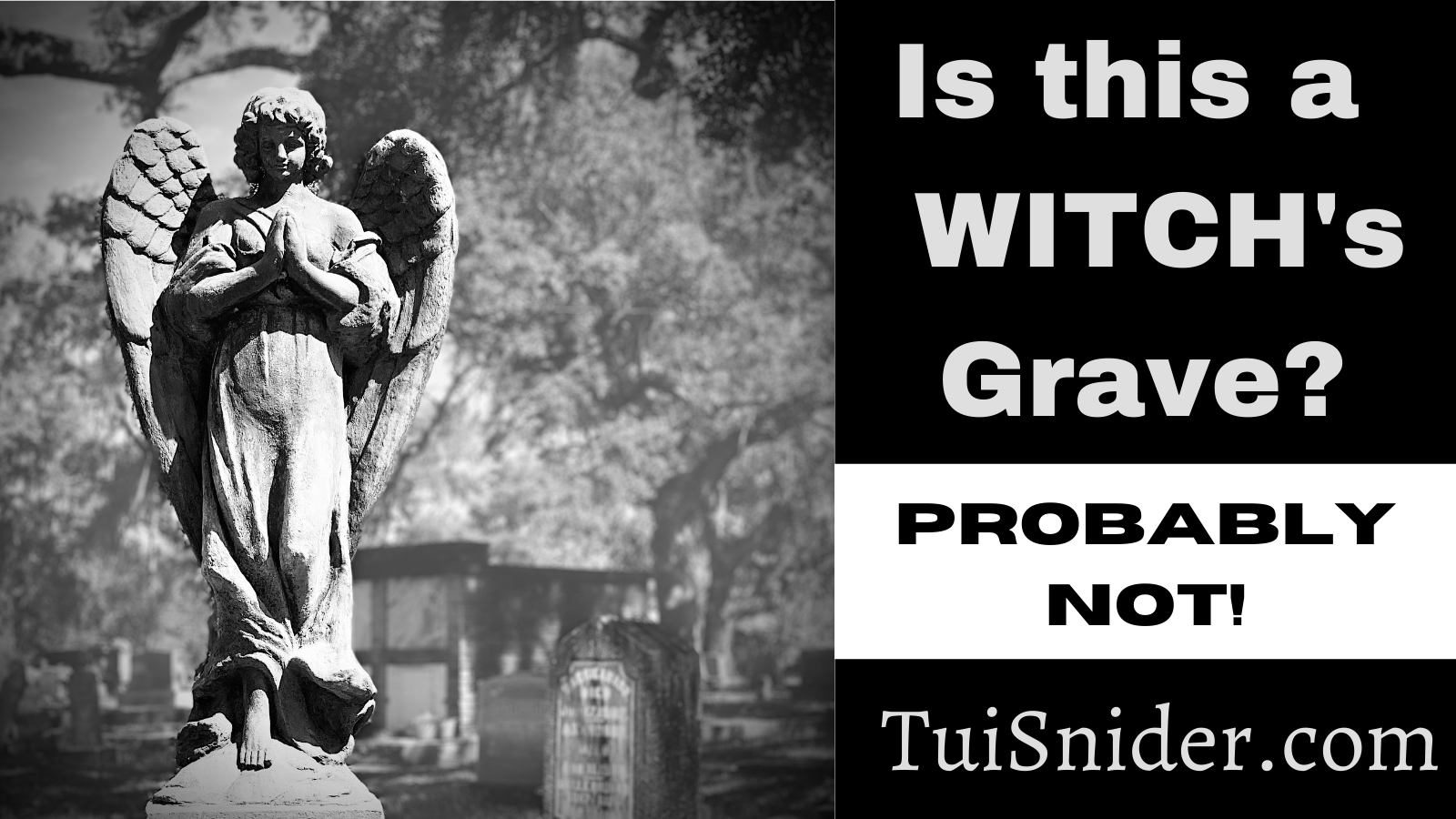
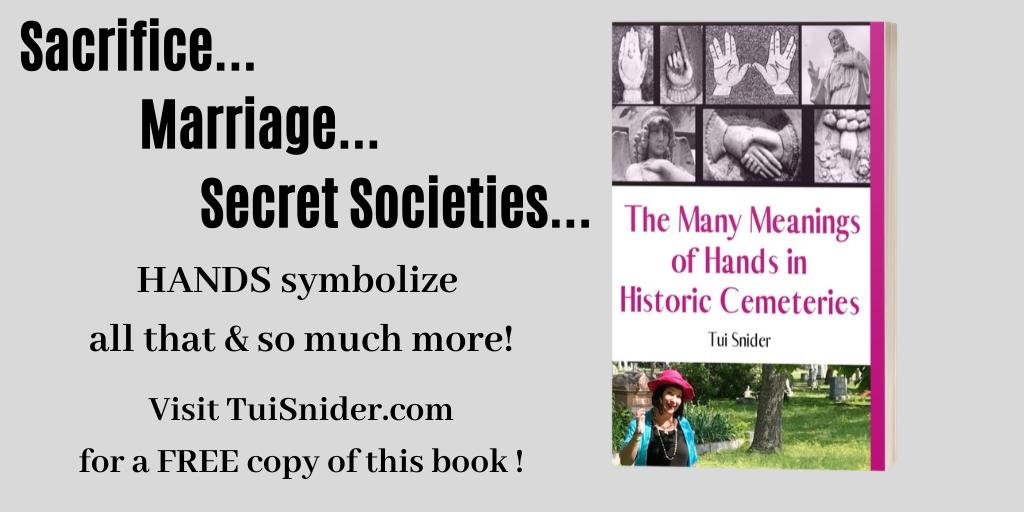
Be First to Comment